What Makes the Lorikeet's Diet Unique Among Parrots?
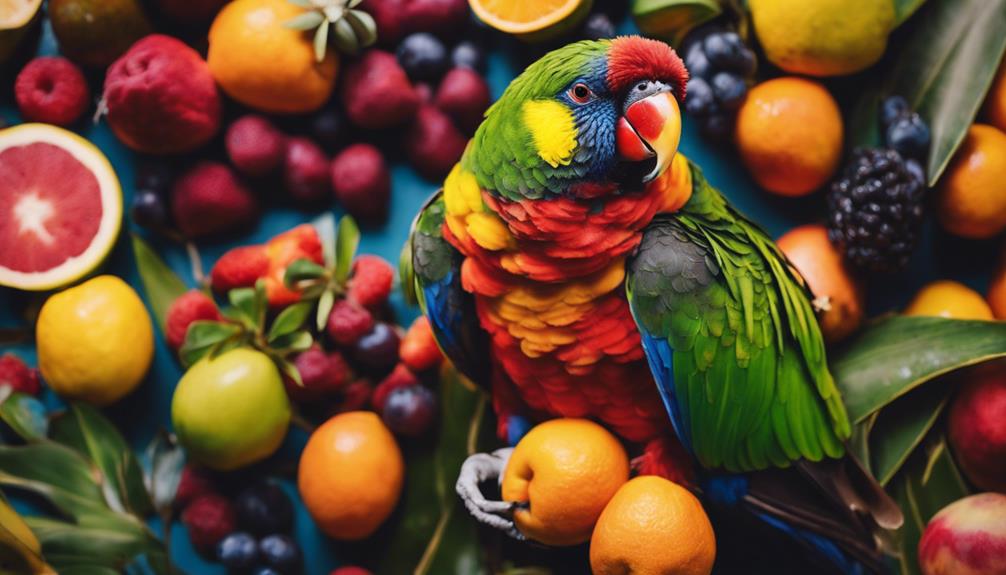
The Lorikeet's diet is unique among parrots due to their consumption of high amounts of nectar, pollen, and other unconventional food sources.
This diverse diet is processed by their specialized digestive system.
It influences their vibrant plumage and contributes to their overall health and well-being.
Brush-tipped Tongues
Lorikeets possess specialized brush-tipped tongues that enable them to efficiently extract nectar from flowers. These tongue adaptations are crucial for their feeding efficiency, allowing them to access nectar that other parrots might struggle to reach. The brush-like structure of their tongues helps in gathering and transporting nectar up to their mouths with remarkable precision.
Furthermore, the unique design of their tongues isn't only about extracting nectar but also plays a role in their taste preferences. Lorikeets have taste receptors not only on their tongues but also at the back of their throats, aiding in their ability to detect and enjoy a wide variety of nectar sources. This specialized adaptation allows lorikeets to not only sustain themselves but also thrive on a diet primarily consisting of nectar.
High Nectar Consumption
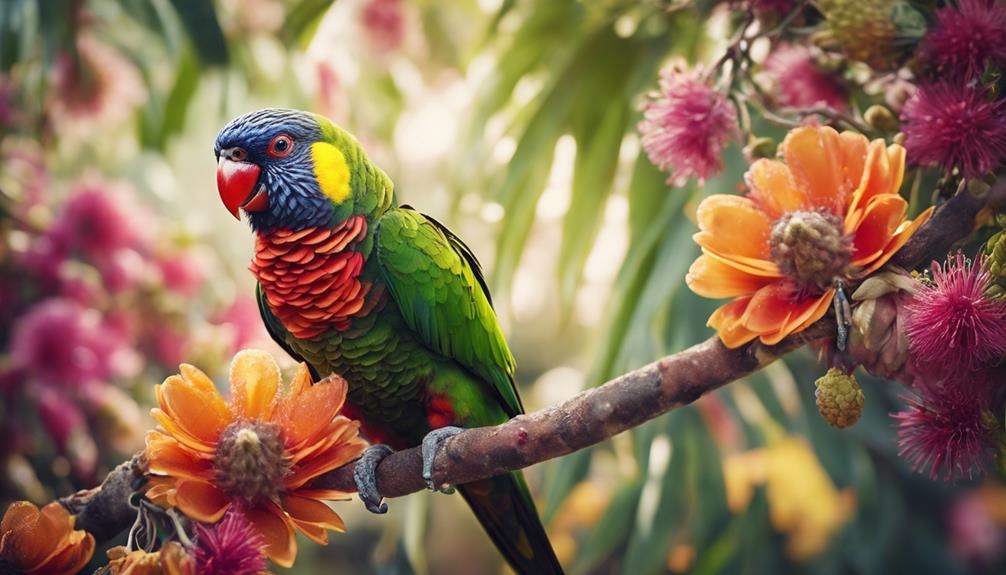
Lorikeets, known for their vibrant plumage and energetic demeanor, have developed a remarkable adaptation for high nectar consumption. Their brush-tipped tongues, specialized for extracting nectar from flowers, allow lorikeets to efficiently feed on the sugary liquid.
This unique feeding behavior not only benefits the lorikeets but also plays a crucial role in pollination and ecosystem health.
Nectar-Rich Diet Benefits
Consuming a diet rich in nectar provides lorikeets with essential nutrients and energy due to its high sugar content and easily digestible properties, supporting their active lifestyle and vibrant plumage. Lorikeets benefit from this specialized diet in various ways:
- Energy Efficiency: Nectar is a rapid energy source, allowing lorikeets to sustain their high metabolic rate.
- Sugar Metabolism: Their unique digestive system efficiently processes the sugars in nectar for quick energy release.
- Floral Diversity: Lorikeets feed on a wide range of flowers, ensuring a diverse nutrient intake.
- Taste Preferences: Their taste buds are adapted to detect the specific flavors of nectar-rich flowers.
- Nutritional Balance: Nectar provides lorikeets with vitamins, minerals, and antioxidants crucial for their health and vitality.
Lorikeet Feeding Behavior
In studying lorikeet feeding behavior, researchers have noted a distinct pattern of high nectar consumption that reflects the bird's specialized dietary needs and foraging strategies. Lorikeets possess unique feeding adaptations that enable them to efficiently extract nectar from flowers.
Their tongue anatomy plays a crucial role in this process, featuring specialized brush-like papillae at the tip to collect and transport nectar. This adaptation allows lorikeets to lap up large quantities of nectar from blossoms rapidly. Moreover, their nimble tongues can extend far beyond their beaks, reaching deep into floral crevices to access hidden nectar sources.
This feeding behavior showcases the lorikeet's remarkable ability to thrive on a diet primarily composed of nectar, highlighting their evolutionary specialization for consuming this nutrient-rich food source.
Unique Digestive System
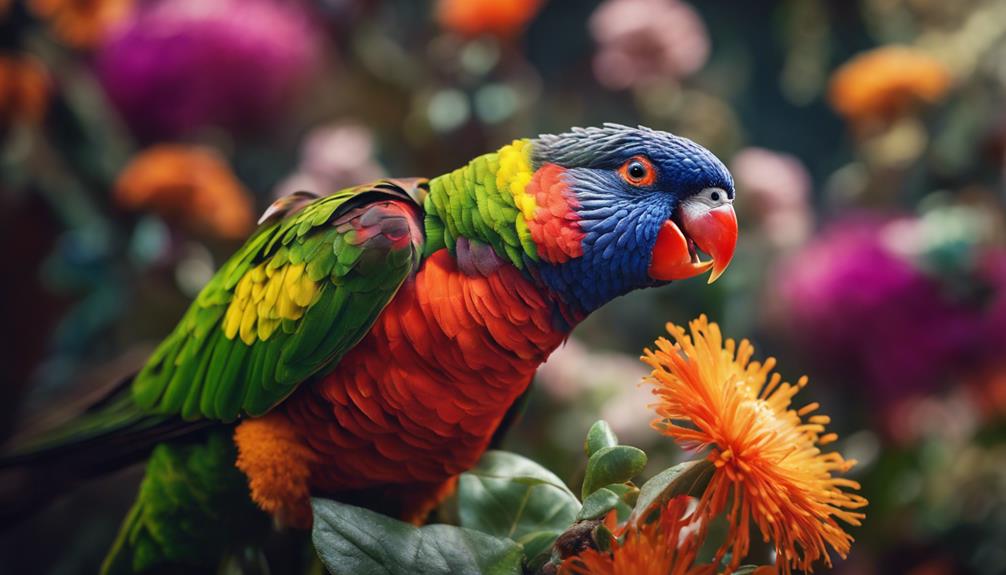
The lorikeet boasts a specialized digestive tract that's finely tuned to process its high nectar diet efficiently. This unique system allows for rapid metabolism, ensuring the bird can extract essential nutrients swiftly from its food source.
With an emphasis on nutrient absorption, the lorikeet's digestive system showcases remarkable adaptions to support its distinctive dietary needs.
Specialized Digestive Tract
Possessing a specialized digestive tract, lorikeets exhibit a unique system that enables efficient processing of their nectar-based diet. These birds have evolved distinct adaptations to suit their dietary needs, including:
- Crop: Lorikeets have an enlarged crop to store nectar before it moves to the stomach for digestion.
- Proventriculus: This organ secretes digestive enzymes that help break down the complex sugars present in nectar.
- Gut microbiota: Lorikeets harbor specialized gut bacteria that aid in fermenting and extracting nutrients from the nectar.
- Long intestines: Their intestines are longer to maximize nutrient absorption from the liquid diet.
- Rapid digestion: Lorikeets have a fast digestive transit time to efficiently process the high-sugar content of nectar.
Efficient Nutrient Absorption
Lorikeets' efficient nutrient absorption is facilitated by their unique digestive system, which includes specialized adaptations for processing their nectar-based diet. These birds have a rapid digestive process that allows for efficient extraction of nutrients from the sugary nectar they consume.
Their digestive tract is specifically designed to handle this liquid diet, featuring a short gastrointestinal transit time that aids in the quick absorption of essential nutrients. Additionally, lorikeets possess a highly developed crop that acts as a holding chamber for consumed nectar before it moves on to the stomach for further processing.
This efficient digestion system enables lorikeets to extract vital vitamins, minerals, and energy from their food source, supporting their active lifestyle and vibrant plumage.
Rapid Metabolism Process
With a metabolism uniquely adapted to their nectar-based diet, lorikeets efficiently process nutrients to sustain their active lifestyle and vibrant plumage. Lorikeets exhibit a rapid metabolic rate, allowing for quick energy expenditure necessary for their agile flight and constant foraging activities. This specialized digestive efficiency is crucial for extracting sugars from the nectar they consume. The lorikeet's digestive system is finely tuned to break down complex sugars into readily available energy. This process enables lorikeets to efficiently convert nectar into fuel, supporting their high levels of activity throughout the day.
- High metabolic rate: Lorikeets have a fast metabolism that aids in quick energy conversion.
- Digestive adaptation: Their digestive system is uniquely designed for nectar breakdown.
- Efficient energy extraction: Lorikeets extract sugars efficiently from nectar.
- Optimized fuel utilization: Nectar is rapidly converted into energy for their active lifestyle.
- Sustaining activity levels: This metabolic process supports their constant foraging and flight.
Pollen as a Food Source
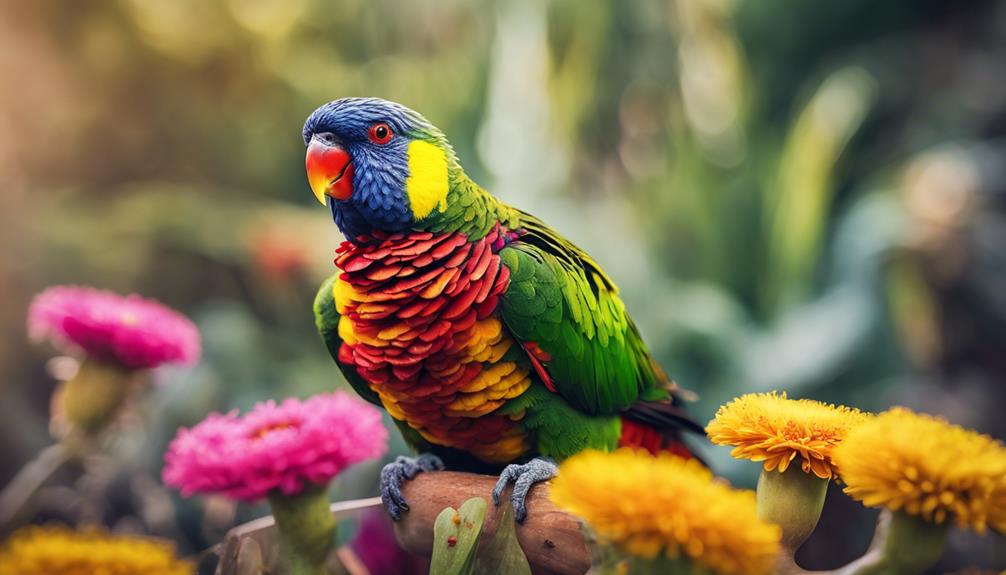
Pollen serves as a crucial food source for lorikeets due to its high nutritional content and role in their specialized diet. Lorikeets have a unique digestive system that allows them to efficiently break down pollen. Their rapid metabolic rate enables them to extract essential nutrients from pollen quickly, supporting their active lifestyle.
Additionally, lorikeets have a preference for nectar, which is rich in sugars but lacks some vital nutrients. Thus, pollen becomes essential for providing lorikeets with proteins, fats, vitamins, and minerals that may be lacking in their primary food source. The efficient digestion of pollen ensures that lorikeets can absorb a wide range of nutrients, promoting their overall health and well-being.
This specialized adaptation highlights the lorikeet's ability to thrive on a diverse diet, showcasing their remarkable ability to utilize pollen as a critical component of their nutritional intake.
Specialized Feeding Behavior
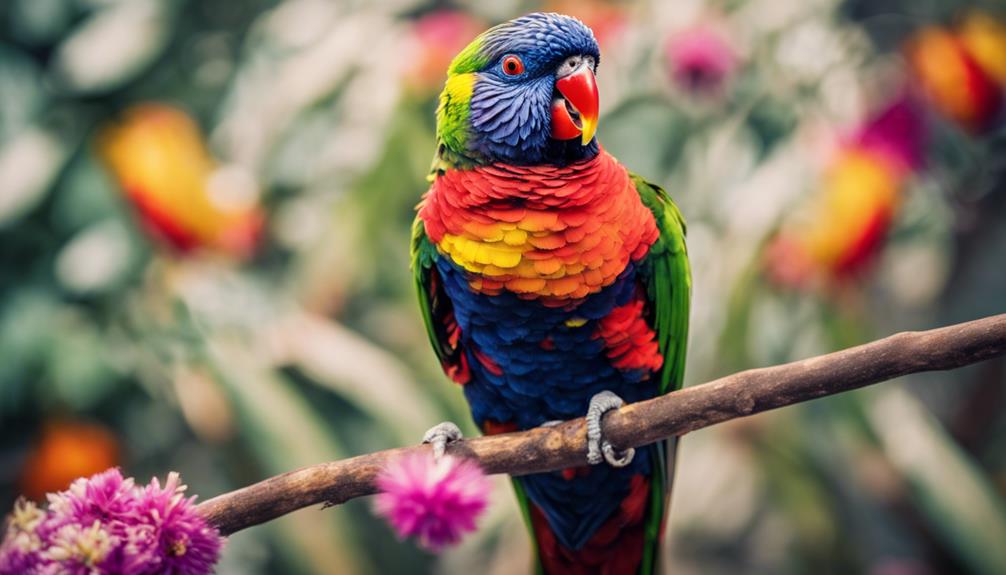
An intriguing aspect of the lorikeet's behavior related to feeding is its specialized approach to obtaining and processing nutrients. Lorikeets exhibit unique foraging techniques and feeding preferences that set them apart from other parrots.
Here are five key points that highlight the specialized feeding behavior of lorikeets:
- Nectar Feeding: Lorikeets have evolved to be nectarivores, with a strong preference for consuming nectar from flowers.
- Pollen Consumption: In addition to nectar, lorikeets also consume pollen as a significant part of their diet, providing essential nutrients.
- Fruit Consumption: While nectar and pollen are primary food sources, lorikeets also consume fruits, contributing to their diet diversity.
- Selective Feeding: Lorikeets are selective feeders, often preferring specific plant species for their nectar and pollen.
- Efficient Digestion: Their specialized feeding behavior is complemented by efficient digestive systems that help process the sugary nectar and pollen effectively for nutrient absorption.
These feeding behaviors showcase the lorikeet's unique adaptations for their specialized diet.
Nutrient-rich Diet
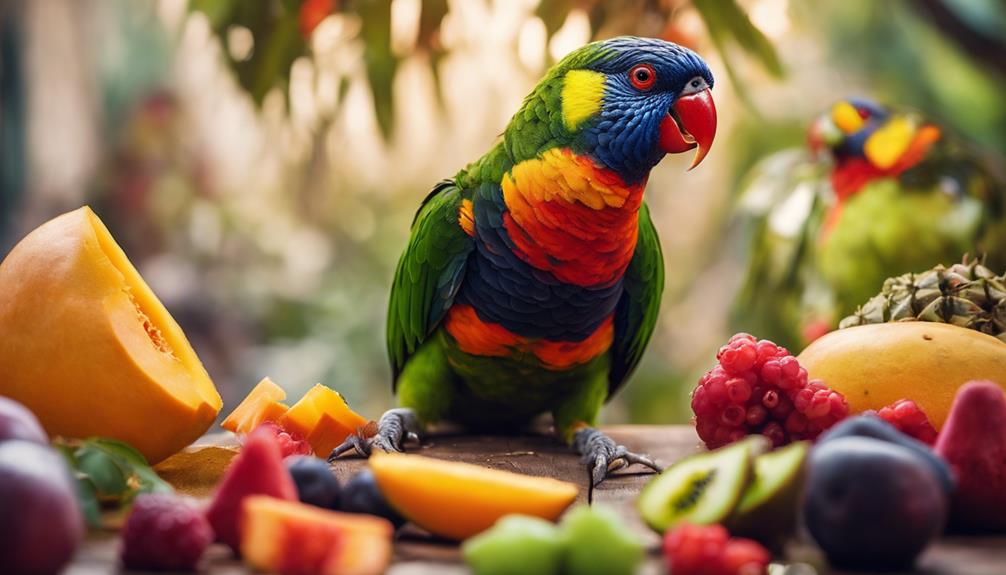
Lorikeets' specialized feeding behavior ensures they maintain a nutrient-rich diet essential for their unique dietary requirements. These birds have developed remarkable dietary adaptations to thrive on a diet primarily consisting of nectar, pollen, fruits, and some insects. Their feeding habits, characterized by a brush-like tongue adapted for collecting liquid foods, allow them to efficiently extract nutrients from their food sources. This specialized tongue structure aids in maximizing nutrient absorption, crucial for meeting the lorikeet's high metabolic rate and energy demands.
Due to their liquid-based diet, lorikeets have evolved to possess a digestive system that rapidly processes food, enabling them to obtain essential nutrients efficiently. This rapid digestion process is necessary for these birds to extract sufficient energy from their food sources and support their active lifestyle. Lorikeets' ability to extract a wide range of nutrients from nectar and pollen showcases their exceptional dietary specialization, setting them apart from other parrot species. Their nutrient-rich diet plays a significant role in maintaining their overall health and vibrant plumage, a topic we'll explore further in the next subtopic.
Impact on Plumage
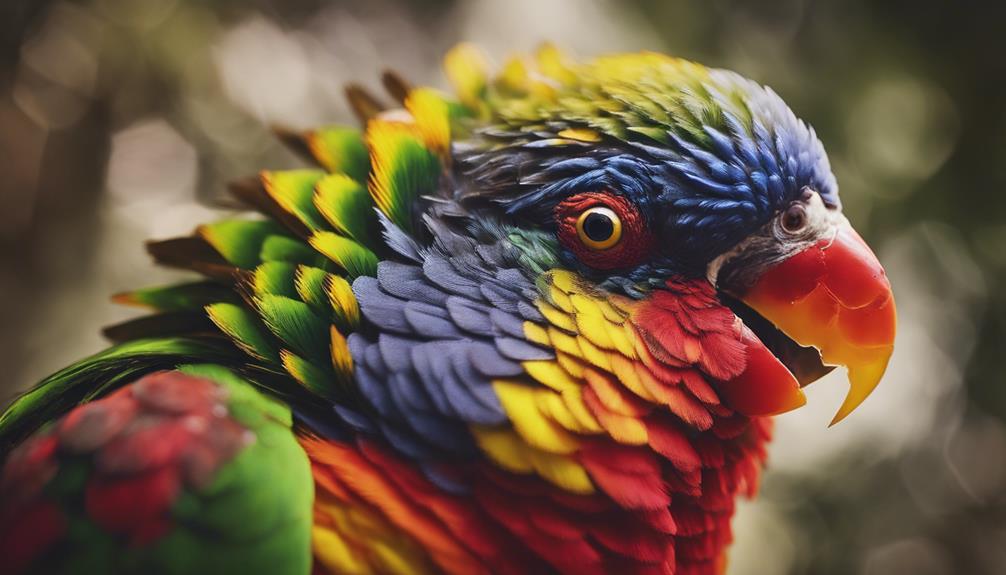
The vibrancy and health of a lorikeet's plumage directly reflect the impact of its specialized nutrient-rich diet. Lorikeets, due to their unique dietary habits, exhibit remarkable changes in their plumage, affecting not only their appearance but also their behavior.
- Intense Coloration: Lorikeets display vivid and striking colors on their feathers, showcasing the richness of their diet.
- Glossy Sheen: The feathers of lorikeets often have a glossy sheen, indicating good health and proper nutrition.
- Behavioral Vibrancy: Lorikeets with vibrant plumage tend to be more active and playful, showcasing the link between diet and behavior.
- Coloration Changes: The feathers of lorikeets may change in hue and intensity based on seasonal variations in their diet.
- Health Indicators: Dull or faded plumage can signal nutritional deficiencies, highlighting the importance of a balanced diet for lorikeets.
Frequently Asked Questions
How Do Lorikeets Use Their Brush-Tipped Tongues to Extract Nectar From Flowers?
Lorikeets use their brush-tipped tongues to extract nectar from flowers by inserting them into the flower and using the brush-like structures to collect the nectar. This unique tongue anatomy aids in their efficient foraging behavior.
What Specific Adaptations Does the Lorikeet's Unique Digestive System Have to Process a High Nectar Diet?
The lorikeet's digestive adaptations are fascinating. Its unique system has evolved to efficiently process a high nectar diet. Nectar processing techniques include a specialized crop that ferments the liquid, aiding in the breakdown of sugars for energy.
Why Do Lorikeets Rely on Pollen as a Food Source, and How Does It Contribute to Their Overall Diet?
When it comes to lorikeets, the reliance on pollen isn't just a choice; it's a necessity. Pollen consumption plays a crucial role in their diet, providing essential nutrients and aiding in their digestive system's efficiency for optimal lorikeet health.
What Specialized Feeding Behaviors Do Lorikeets Exhibit That Set Them Apart From Other Parrot Species?
Lorikeets demonstrate unique feeding habits compared to other parrot species. Their evolved tongue structure allows them to extract nectar efficiently, aiding in pollination while offering evolutionary advantages. These specialized behaviors contribute to their distinct ecological niche.
How Does the Lorikeet's Nutrient-Rich Diet Impact the Health and Vibrancy of Their Plumage Compared to Other Parrots?
The lorikeet's nutrient-rich diet impacts the health and vibrancy of their plumage significantly. Their efficient nutrient absorption leads to vibrant feathers with a unique iridescence, setting them apart from other parrot species in terms of feather quality.










